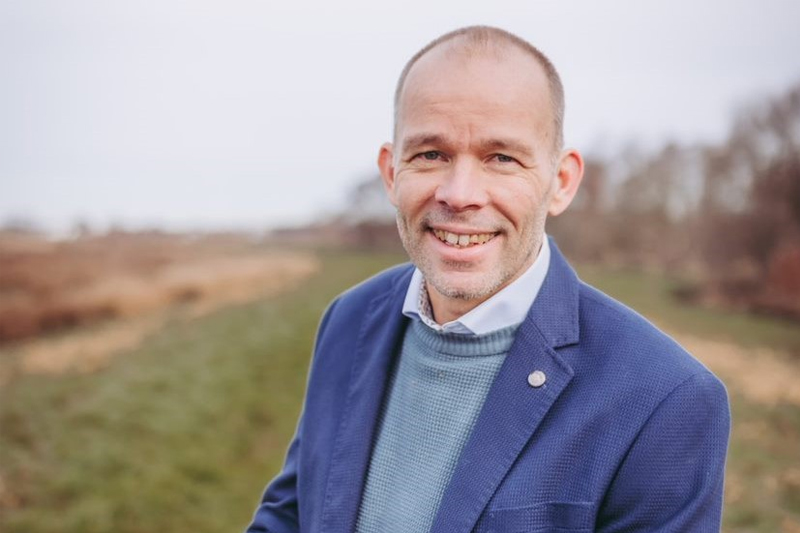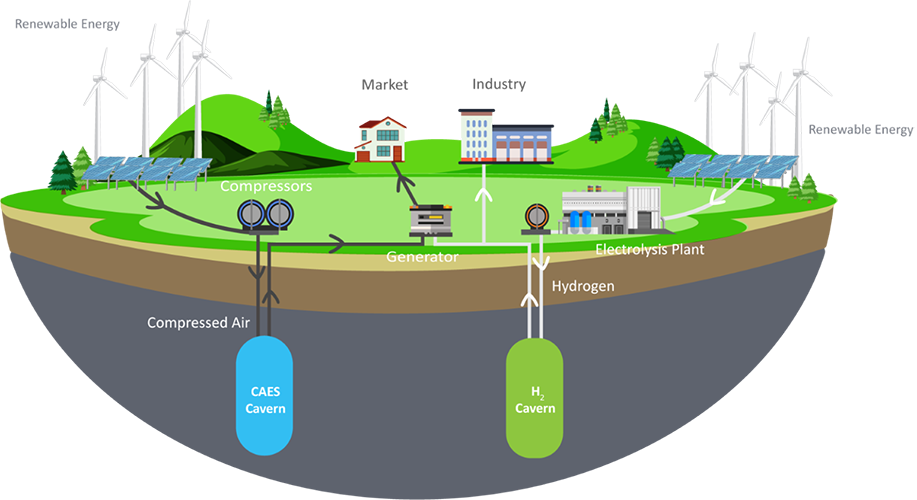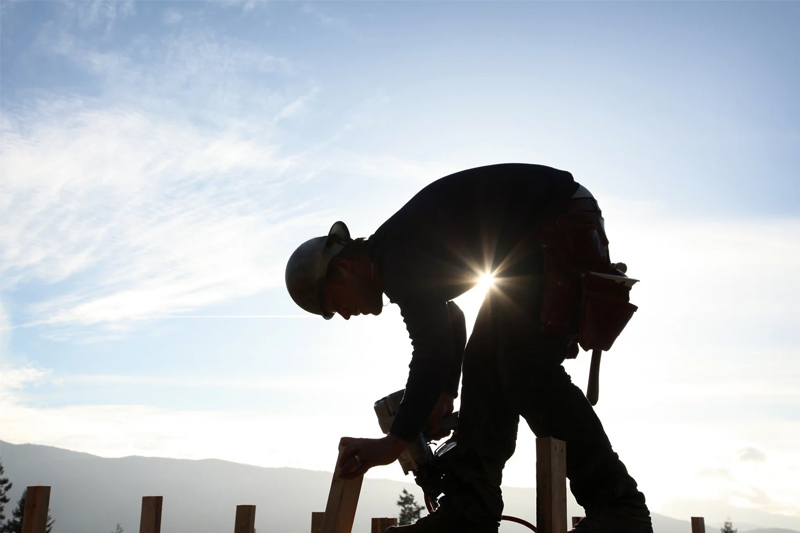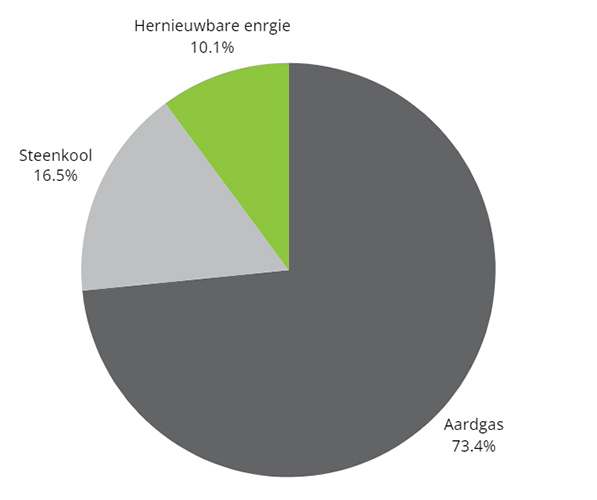A large battery
driven by compressed air?
How is it possible that are creates energy? That is a question we hear quite often. Therefore we will explain the technique step by step. When the wind blows and the sun shines a lot of sustainable energy is generated. However, there is a major problem; the energy network is out of balance during sunny and windy days as there is a limit to the amount of energy it can transport. To solve this problem the wind mills and solar panels are turned off. Therefore a lot of sustainable energy is not being used. That is what we would like to change by saving sustainable energy for the days the wind doesn’t blow and the sun doesn’t shine. By turning the sustainable energy into compressed air, save it in a cavern and let the air out through a turbine which turns it into energy again we prevent us from using fossil fuel.
All in all, this technique is called compressed air energy storage (CAES).
The Design
It all starts with the design of the installation and the two salt caverns in which compressed air is stored. Our colleague Hedzer is responsible for this. The permits are then applied for and the design is worked out down to the smallest detail. Once the necessary permits have been granted, the actual construction begins.


The Construction
The construction can roughly be divided into two parts: the underground salt caverns and the installation. Subterranean salt caverns are large, solid cavities in the salt layers in the soil that are made by dissolving salt. This can be done by pouring water into the salt layer, which makes salt liquid, this is called brine. The brine is transported via pipes to the industry. After that, the cavern needs rest before it is put into use. Parts are then placed at the top of the cavern to make the connection with the above-ground installation.
The installation that will be built on the surface consists of compressors to compress air and pump it into the cavern. During the compression of air, a lot of heat is released. To cool that air before it enters the cavern, we use hybrid cooling towers. As a result, the temperature in the cavern is around 50 degrees Celsius. This is an ideal temperature to ensure the stability of the cavern. During the operation of the CAES facility, in the storage phase, electricity is used to force air into the cavern. In the generation phase, the compressed air is released and heated to drive turbines, which produces electricity when needed. When feeding power back into the electricity grid, we use two Turbine Expanders with a total capacity of 320 MW. During the expansion of the air, it cools down.


Facts and Figures
In the Netherlands, we use 58% natural gas, 26% coal and 13% other forms of energy to generate electricity. Only 8% of our energy comes from renewable energy sources.
Our technology makes it possible to store 4 gigawatts of energy. This can be compared to the electricity needs of approximately all households in the province of Groningen.
STAY INFORMED WITH THE LATEST NEWS
FOLLOW THE STORY ON INSTAGRAM
Apr 10

Als onze installatie gebouwd wordt bestaat die bouw uit twee delen:
- onder de grond om holtes in de zoutlaag te maken waar we perslucht in opslaan (dat doen we in samenwerking met een ander bedrijf die het zout gebruikt voor de industrie).
- boven de grond om lucht naar beneden te brengen en om het om te vormen in energie en het door te geven aan het energienetwerk.
Alles dat in de bodem plaatsvindt vindt men spannend. Logisch. Zeker in Groningen gezien de problemen die er ontstaan zijn door de gaswinning.
We zouden natuurlijk nooit aan dit project beginnen als het niet veilig is.
Er zijn namelijk grote verschillen tussen gaswinning uit zandsteen en opslag van perslucht in een zoutcaverne. Deze twee zijn eigenlijk als appels en peren. Ze zijn bijna niet te vergelijken.
Aardbevingen bij gaswinning ontstaan omdat er door de winning spanning wordt opgebouwd op de grote breuken in het reservoir. Het plotseling vrijkomen van deze spanning is een aardbeving. Gas zit in een zandsteenlaag op 2600 en 3200 meter diepte.
Zoutcavernes zijn onnoemelijk veel kleiner dan gasvelden en liggen minder diep in de ondergrond (bij Zuidwending op 1.000 meter). Hierdoor is ook de bodemdalingsschotel van een zoutcaverne vele malen kleiner dan die van een gasveld.
De persluchtopslag vindt plaats in een caverne in het zout. Zout heeft een dichte structuur, en er zitten geen grote breuken in. Er kunnen dan ook geen grote spanning worden opgebouwd die vrij kan komen als aardbeving. Het opslaan van lucht in cavernes zal dan ook geen aardbevingen kunnen veroorzaken zoals die bij de gaswinning zijn gevoeld. Wat wel mogelijk is dat er microseismische activiteit ontstaat tijdens het gebruik van de caverne door kleine bewegingen in het zout. Door deze te meten kan Corre Energy volgen hoe de caverne zich gedraagt tijdens de perslucht opslag. Daarom zal Corre Energy deelnemen in het microseismisch monitoringsnetwerk dat EnergyStock en Nobian rondom de Zuidwending zoutdome hebben geïnstalleerd.
We zullen hier de komende tijd meer over delen. Heb je vragen of maak je je zorgen? Stuur een DM of mail naar [email protected].
Meer informatie vind je ook op onze site bij de FAQ’s.
...
Apr 10

Het gebruik van perslucht gaat meer dan 4.000 jaar terug en is altijd een belangrijke motor geweest voor technologische vooruitgang.
Hoewel deze historische toepassingen niet gericht waren op energieopslag, bieden ze inspiratie om energie-efficiëntie van de huidige CAES-systemen te verbeteren.
Hieronder lees je een korte samenvatting:
De eerste perslucht techniek werd gebruikt om vuur aan te wakkeren. Dit werd gedaan met een zogenaamde blaasbalg. Dat is een soort pomp om lucht te richten op het hout dat je wilt verbranden.
👉 1857: Daarna werd CAES gebruikt in de mijnbouw om rotsboren aan te drijven. Dit kreeg meer naamsbekendheid toen er in 1871 de 13,7 km lange Mont Cenis Tunnel gegraven werd.
👉 1880: Daarna kreeg CAES ook bekendheid in de USA om rotsboren transport-, pomp- en stempelmachines aam te drijven.
👉 1889: Het persluchtnetwerk in Parijs begon als een systeem dat uitsluitend was ontworpen voor het regelen van klokken door impulsen van perslucht die door ondergrondse leidingen werden gestuurd.
👉 In 1889 regelde het netwerk in Parijs 8.000 klokken via 65 km leidingnet.
👉 Over een periode van 33 jaar vanaf 1896 werden achttien gigantische hydraulische luchtcompressoren gebouwd, voornamelijk in de VS, Canada, Duitsland en Zweden.
👉 In 1978 in Duitsland is een CAES plant in productie gegaan en draait nog altijd.
👉 Evenals de CAES in de VS die al sinds 1991 energie opslaat en levert wanneer het nodig is.
Wij voegen onze CAES installatie in de toekomst graag toe aan dit lijstje!
#caes #perslucht #duurzaam #groeneenergie #duurzaamnederland #windenergie
...
Apr 3

Dit is waarom jij ook wilt dat CAES (compressed air energy storage) in Nederland komt. Het levert ons allemaal veel op. Swipe maar eens door de foto’s!
#caes #caesnederland #hernieuwbareenergie #renewables #duurzameenergie #duurzaam #groeneenergie #duurzaamheid #klimaat #klimaatneutraal #co2neutral
...
Feb 7

Door groene energie op te slaan voor momenten dat er weinig wind en zon is, zijn we steeds minder afhankelijk van fossiele brandstof. Daarmee behouden we de natuur en blijft de wereld groen. Ook voor de volgende generaties!
Help je ons door ons te volgen, ons profiel te delen en vooral je vragen te stellen?
#sustainableenergysolutions #sustainability #duurzaam #duurzaamheid #persluchtopslag #persluchttechniek #caes #compressedairenergystorage #duurzaamondernemen #groeneenergie #windenergie #zonneenergie
...
Feb 7

Een van de grootste voordelen van perslucht opslag is de hoeveelheid energie die we kunnen leveren.
Batterijen kunnen zo’n zes uur energie leveren. Supergoed natuurlijk! Maar dat is lang niet voldoende.
In Nederland zijn er vaak perioden van drie tot vijf dagen dat er weinig wind en zon is. Daarom hebben we meer groene energie nodig dan alleen batterijen kunnen leveren. Hiermee voorkomen we het gebruik van fossiele brandstof.
Wij geven een flinke duw in de goede richting!
Wil je meer weten? Check onze website voor meer informatie of stuur een DM!
#correenergy #persluchtopslag #sustainability #caes #050 #groningen #duurzaam #duurzaamheid #sustainableliving #sustainabledevelopment #sustainableenergy #sustainableenergysolutions
...
Nov 16

Opslag van duurzame energie is nog geen feit. Daarom moeten we zuinig zijn met de groene energie die er wél is om het verbruik van fossiele brandstoffen te verminderen.
Hoe? 🤷♀️
Maak een schermafbeelding voor een taakje in de groene richting!
Let’s go! 💪
...
Nov 15

Onze collega Hedzer werkt hard aan onze techniek.
🤔 Nou horen we je denken, jullie zijn nog niet in de uitvoerende fase toch?
✅ Klopt!
En toch zit Hedzer niet bepaald stil. Swipe maar eens door deze foto’s om erachter te komen wat er achter de schermen gebeurd!
#renewableenergies #herbruikbareenergie #nieuweenergie #duurzaam #caes #persluchtopslag #groenergie #klimaatdoelen
...
Nov 13

Dat het niet zo best gaat met onze natuur wist jij natuurlijk al lang. Maar het is wél onze grote drijfveer om groene energie beschikbaar te maken als er weinig wind en zon is.
Leef klimaat neutraal op kleine en grote schaal!
#hernieuwbareenergie #renewableenergies #caes #duurzaam #sustainability #correenergy #groenenergie
...
Nov 8

Wist je dat we heel graag jouw vragen over ons project beantwoorden? Check de FAQ’s op de site of stel je vraag hier!
#persluchtopslag #renewableenergy #herbruikbareenergie #sustainability #duurzaam #duurzaamheid #groeneenergie
...
Sep 27

Tot onze grote schrik kwamen we erachter dat er een klein laagje stof op onze socials lagen. Tijd voor een vette update dus!
Met een team van onder andere geologen, technici, communicatie specialisten, stakeholder managers en juristen timmeren we lekker aan de weg.
Dit is waar we ons op dit moment mee bezig houden vanuit ons kantoor in de Groningse media centrale:
- Vergunningen
- Nieuwe website
- Persluchtopslag op de publieke agenda
- Aankoop land
De wereld van de duurzame energie opslag is nieuw en er zijn veel nieuwe ontwikkelingen. Daarom zijn er veel kansen en soms een ook hobbels op de weg. Hierover vertellen we je in een volgende post meer!
Heb je vragen over ons project? Stuur een DM of reageer in de comments ⬇️.
👋 Team Corre Energy
...

Email
[email protected]
Telephone
+31 50 799 5056
Corre Energy Storage B.V., Helperpark 278-3, 9723 ZA, Groningen, The Netherlands
Registered in the Netherlands with Company Number: 72798815
Copyright Corre Energy © 2024. All rights reserved.



